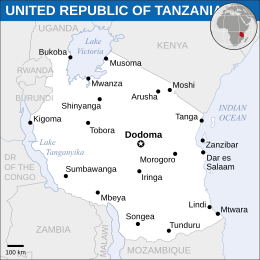More languages
More actions
| United Republic of Tanzania Jamhuri ya Muungano wa Tanzania | |
|---|---|
 | |
| Capital | Dodoma |
| Largest city | Dar es Salaam |
| Official languages | Swahili English |
| Dominant mode of production | Capitalism |
| Area | |
• Total | 947,303 km² |
| Population | |
• 2023 estimate | 65,642,682 |
Tanzania, officially the United Republic of Tanzania, is a country in East Africa.
History
British occupation
Workers in the shipping, post, diamond, and rail industries led a series of strikes in 1958 to win independence from Britain.[1]
Independence
In the early 1960s, Tanzania did not largely intervene with small farmers besides improving irrigation.
In 1967, President Julius Nyerere announced the creation of a socialist state in the Arusha Declaration. He nationalized key industries while developing agriculture and industry. He merged all unions into the National Union of Tanganyika Workers.
Nyerere encouraged all peasants to move to collective ujamaa villages. This system failed to deal with the patriarchal relations of the countryside and often relied on force because it did not take time to persuade the peasantry.[1]
References
- ↑ 1.0 1.1 Vijay Prashad (2008). The Darker Nations: A People's History of the Third World: 'Arusha' (pp. 191–6). [PDF] The New Press. ISBN 9781595583420 [LG]


